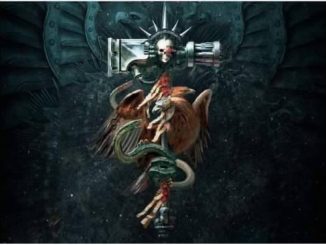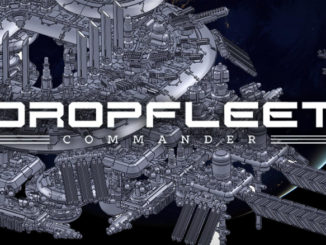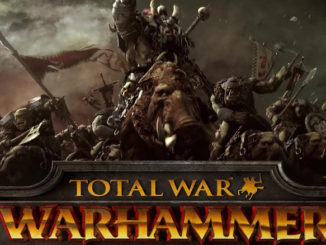
Hello everyone, Danny here to talk about the new GW competitive game, Shadespire! You should totally check out the video that Tommy and I made as we stumbled through a game.
Overview:
Shadespire is an “arena” level tabletop game, so really, a few models on each side with the smallest team being 3 models and the largest so far being 7 models. This is a bit smaller than a skirmish sized game like Necromunda or even Infinity, so GW is clearly trying to reach into a share of the market that isn’t as crowded as the only somewhat successful arena games I can think of are Arena Rex and Krosmaster.
The game scales between 2 and 4 players, which is nice actually as it opens it up a bit to more casual play with several teams going at it. The win mechanic is simple: whoever achieves the most glory points at the end of 3 turns wins, and glory is scored by completing objectives or killing enemy fighters.
There are three levels to the game essentially, board control, dice, and cards. This adds a certain amount of both randomness and complexity. How you control the board, react to your opponent, and pursue the objectives are entirely in your control, so really, this is where skill is going to have the most direct impact. Attacks and defense as well as who goes first are decided by dice, so there is far bit of deviation here, and as such, you as a player do not have as much control. Finally, you build your deck of upgrades, reactions, and game-state manipulation as well as your objective deck, so while there is randonmess involved in what you draw, your skill at deck construction is going to factor in significantly, especially since ploys are a great way to help mitigate the randomness of the dice. I really enjoy this balance as skills and player decisions have a large impact on success, but there is still enough chaos within it that forces players to adapt and gives less skilled players a chance to succeed when outclassed.
Fun Factors:
The game is relatively easy to learn, and once you have the basic hang of it, it plays fast. Even just stumbling through a few games, I’ve yet to have a game go past 30 minutes, and a large part of this is that there are really only 12 activations. At most, assuming everyone charges every activation, that is only 12 models moving and 12 attack/defense rolls. Yes, thanks to ploys and the card mechanic, you will get a bit more out of each activation, but really, there is a slim economy of “stuff” happening that makes the game lean and fast.
Part of this rapid pace is that as a player, you are never truly inactive. I have never spent more than 30 seconds waiting for something playing a game. I activate a model, complete their action, then decide if I want to play a power card, and then my opponent has the chance to respond, and I have a chance to respond, and so forth. When my opponent plays a power on their turn, I get to react. As attack/defense is an opposed roll, even when my opponent is attacking me, I still have things to do. There is constant player engagement here, and that really does make it feel even faster than it is. Having played a lot of Warmachine, essentially turning off for 10-15 minutes several times a game is no bueno. This also happens in 40K during enemy movement, which can take quite a bit of time.
The math behind the game is relatively solid and rewards model positioning. The attack and defense dice are divided into types, hammers and swords for attack and shields or dodge for defense, and characters rely on one set over the other. This makes the odds of you landing with just one die rather low, but when your attack or defense is supported by friendly models, what I call half-moons and moons (support sides) count as successes, so your odds of landing hits or evading damage become much higher, and again, this really does reward player decisions.
Another enjoyable part of the game is the customization option. Being able to tailor your powers and objectives to your preferred playstyle gives it just enough granularity to add a surprising amount of depth and replayability. While there will inevitably be maximum efficiency decks for each team, the fact that you have the opportunity to build your overall strategy to your liking is a nice addition without adding so many variables that balance becomes elusive. While some lament that teams are fixed, I enjoy this as it makes balance far more obtainable as there are less unforeseen interactions.
The models themselves are pretty awesome for push-fit. Each one has a lot of character and a distinct sense of movement, even the undead. It is also nice that you can paint 4 or 5 models and have a whole team done, so whether it is getting them done fast or making each one a masterwork, there is a lot of hobby options in those little boxes. It is a little thing, but I really enjoy the size difference between the teams befitting their game board presence, meaning the 7 skelly team are all on 25mm bases and are noticeably smaller than the 5 man team of berserkers on 32mms, and the 3 strong team of Stormcast? They are beefy and on 40mm bases. It is a small matter, but it is a nice detail.
The cost, so far, is also reasonable. For less than a Magnus or Morty, you can get all 4 starting factions and their cards. That’s not bad at all, and with 4 teams and all the cards to build a variety of decks, you have a lot of options in how to build either 4 interesting teams or one super-competitive team.
Eh, s’ok:
The proprietary dice are a bit, whatever. They are just fancy D6s but not. Seems like GW learned a lesson from Fantasy Flight and made sure that there are items in the box that you have to have and well, only GW gets to give it to you. The faction dice are cool looking, but yah, definitely seems like a design choice to enforce a proprietary system rather than something that really accentuates the mechanics of the game.
The roll off mechanic for first turn and what not is a bit odd. Having to roll 4 dice and then see who gets the most criticals is a weird way to determine things, and it can slow down the game immensely as it can take reroll after reroll. It is not a huge issue, but it is definitely not ideal.
The Fighter specific upgrades are generally not worth it. They seem cool and fluffy, and some of them can do work, but yah, they really don’t do enough. I can see some for The Warden for Skellies because he should always be alive or you’ve lost anyway, but for the other factions, they become dead cards far too easily.
The fact that Criticals essentially override infinite successes is a bit much. If you roll one critical on defense and your opponent rolls five successes, you still dodge it all. That can create some super salt, and while it won’t happen often, it definitely sets up a negative experience for somebody. Most of the time, it’s an ok mechanic, but when it sucks, it sucks.
Total Bullshit:
I have to say it, the fact that the best universal cards are spread out across all 4 faction sets means that you have to buy everything if you want to build an optimum deck for any single faction. Both Orruks and Skellies have a few really great universal ploys or upgrades that go great with Khorne or Stormcast, but you need to drop 30 bucks for a faction you don’t want.
I get it, you gotta make money, and it is certainly a good mechanism to get the competitive player to buy more than a single faction if not several to have access to several of these powerful cards, but yah, it is clearly designed to be more about generating revenue than a good play experience.
Overall:
I think Shadespire is one of, if not the, best new games that GW has made, flaws and all. Especially for a gamer like myself who has limited time, being able to get a best of 3 series in 90 minutes is huge. You can play it just about anywhere, and you can still hobby and feel good on that front in a reasonable chunk. From a competitive sense, being able to do a 5 round tournament in about 8 hours is pretty impressive, and a smaller, 16 man tournament can be handled in 6 comfortably with a clear winner.
If you haven’t played it, try it. If you tried it, buy it. If you bought it, say what’s up. Adam, Tommy, and I are talking about maybe trying to get a league going or something, and if you’ve been running one, we’d love to hear your experiences. Also, if you want to see more Shadespire, let us know! We are all about giving you what you want. I can happily do more articles on it as I am having a blast with the game so far.
Thanks as always for reading, the five of you who do (Hi, Ma). Come say hi over at our Facebook page, be sure to subscribe to our Twitch channel, keep on eye on our YouTube channel, and of course, think about that Patreon.









